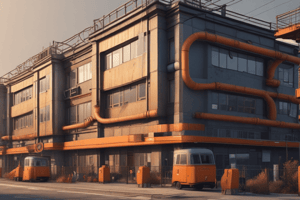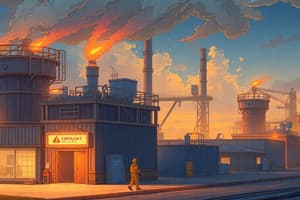Podcast
Questions and Answers
What is an industry?
What is an industry?
- A group of organizations that extracting natural resources
- A group of individuals that provide services
- A group of companies that produce unrelated goods or services
- A group of companies or organizations that produce goods or services that are related or similar (correct)
What is the primary function of primary industries?
What is the primary function of primary industries?
- To extract and process natural resources (correct)
- To provide services
- To manufacture and process goods
- To sell goods
What is the characteristic of the growth stage in an industry's life cycle?
What is the characteristic of the growth stage in an industry's life cycle?
- Industry experiences decline, growth slows, and profit margins decrease
- Growth is slow, and profit margins are low
- Industry expands, growth accelerates, and profit margins increase (correct)
- Industry reaches saturation point, growth slows, and profit margins stabilize
What is the industry structure?
What is the industry structure?
What is the purpose of industry analysis?
What is the purpose of industry analysis?
What is Porter's Five Forces?
What is Porter's Five Forces?
What is the primary function of tertiary industries?
What is the primary function of tertiary industries?
What is the characteristic of the decline stage in an industry's life cycle?
What is the characteristic of the decline stage in an industry's life cycle?
What is the concentration ratio in industry structure?
What is the concentration ratio in industry structure?
What is the primary function of secondary industries?
What is the primary function of secondary industries?
Flashcards are hidden until you start studying
Study Notes
Definition and Types of Industries
- An industry is a group of companies or organizations that produce goods or services that are related or similar.
- Industries can be categorized into different types, including:
- Primary industries: extract and process natural resources, such as agriculture, mining, and forestry.
- Secondary industries: manufacture and process goods, such as construction, manufacturing, and energy production.
- Tertiary industries: provide services, such as healthcare, finance, and tourism.
Industry Life Cycle
- Introduction: new industry emerges, growth is slow, and profit margins are low.
- Growth: industry expands, growth accelerates, and profit margins increase.
- Maturity: industry reaches saturation point, growth slows, and profit margins stabilize.
- Decline: industry experiences decline, growth slows, and profit margins decrease.
Industry Structure
- Industry structure refers to the characteristics of an industry, including:
- Barriers to entry: factors that prevent new companies from entering an industry.
- Concentration ratio: percentage of market share held by top firms in an industry.
- Degree of rivalry: intensity of competition among firms in an industry.
Industry Analysis
- Industry analysis involves examining an industry's structure, trends, and outlook to understand its attractiveness and potential for profitability.
- Key factors to analyze include:
- Market size and growth rate
- Competitive landscape
- Customer needs and preferences
- Technological advancements and innovations
Porter's Five Forces
- A framework for analyzing an industry's competitive environment, including:
- Threat of new entrants
- Bargaining power of suppliers
- Bargaining power of buyers
- Threat of substitute products or services
- Competitive rivalry among existing competitors
Definition and Types of Industries
- An industry is a group of companies or organizations that produce goods or services that are related or similar.
- Industries can be categorized into three main types:
- Primary industries: extract and process natural resources, such as agriculture, mining, and forestry.
- Secondary industries: manufacture and process goods, such as construction, manufacturing, and energy production.
- Tertiary industries: provide services, such as healthcare, finance, and tourism.
Industry Life Cycle
- The industry life cycle consists of four stages:
- Introduction: new industry emerges, growth is slow, and profit margins are low.
- Growth: industry expands, growth accelerates, and profit margins increase.
- Maturity: industry reaches saturation point, growth slows, and profit margins stabilize.
- Decline: industry experiences decline, growth slows, and profit margins decrease.
Industry Structure
- Industry structure refers to the characteristics of an industry, including:
- Barriers to entry: factors that prevent new companies from entering an industry.
- Concentration ratio: percentage of market share held by top firms in an industry.
- Degree of rivalry: intensity of competition among firms in an industry.
Industry Analysis
- Industry analysis involves examining an industry's structure, trends, and outlook to understand its attractiveness and potential for profitability.
- Key factors to analyze include:
- Market size and growth rate.
- Competitive landscape.
- Customer needs and preferences.
- Technological advancements and innovations.
Porter's Five Forces
- A framework for analyzing an industry's competitive environment, including:
- Threat of new entrants.
- Bargaining power of suppliers.
- Bargaining power of buyers.
- Threat of substitute products or services.
- Competitive rivalry among existing competitors.
Studying That Suits You
Use AI to generate personalized quizzes and flashcards to suit your learning preferences.




